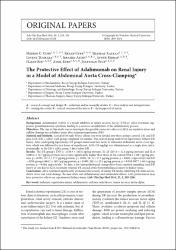The protective effect of adalimumab on renal injury in a model of abdominal aorta cross-clamping

Göster/
Erişim
info:eu-repo/semantics/openAccessTarih
2016Yazar
Cüre, Medine CumhurCüre, Erkan
Kalkan, Yıldıray
Tümkaya, Levent
Aydın, İbrahim
Kırbaş, Aynur
Efe, Hasan
Kurt, Aysel
Yüce, Süleyman
Üst veri
Tüm öğe kaydını gösterKünye
Cure, M. C., Cure, E., Kalkan, Y., Tumkaya, L., Aydin, I., Kirbas, A., Efe, H., Kurt, A., & Yuce, S. (2016). The Protective Effect of Adalimumab on Renal Injury in a Model of Abdominal Aorta Cross-Clamping. Advances in clinical and experimental medicine : official organ Wroclaw Medical University, 25(2), 219–226. https://doi.org/10.17219/acem/33250Özet
Background. Adalimumab (ADA) is a potent inhibitor of tumor necrosis factor (TNF-alpha). ADA treatment suppresses proinflammatory cytokines, leading to a decrease or inhibition of the inflammatory process. Objectives. the aim of this study was to investigate the possible protective effects of ADA on oxidative stress and cellular damage on rat kidney tissue after ischemia/reperfusion (I/R). Material and Methods. A total of 30 male Wistar albino rats were divided into three groups: control, I/R, and I/R plus ADA (I/R + ADA); each group comprised 10 animals. the control group underwent laparotomy without I/R injury. After undergoing laparotomy, I/R groups underwent two hours of infrarenal abdominal aortic cross ligation, which was followed by two hours of reperfusion. ADA (50 mg/kg) was administered as a single dose, intraperitoneally, to the I/R + ADA group, 5 days before I/R. Results. the I/R group's TNF-alpha (1150.9 +/- 145.6 pg/mg protein), IL-1 beta (287.0 +/- 32.4 pg/mg protein) and IL-6 (1085.6 +/- 56.7 pg/mg protein) levels were significantly higher than those of the control (916.1 +/- 88.7 pg/mg protein, + ADA groups (864.2 +/- 169.4 pg/mg protein, p = 0.003; 241.4 +/- 33.4 pg/mg protein, p = 0.010; 987.7 +/- 66.5 pg/mg protein, p = 0.004, respectively). To date, a few histopathological changes have been reported regarding renal I/R injury in rats due to ADA treatment whereas I/R caused severe histopathological injury to kidney tissue. Conclusions. ADA treatment significantly attenuated the severity of kidney I/R injury, inhibiting I/R-induced oxidative stress and renal damage. Because of its anti-inflammatory and antioxidant effects, ADA pretreatment may have protective effects on experimental kidney injury

















